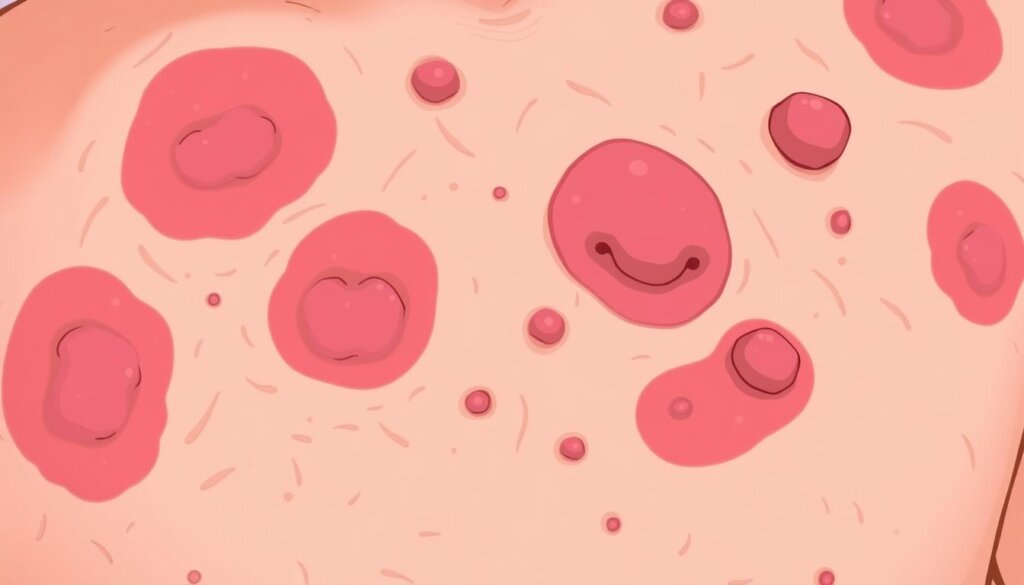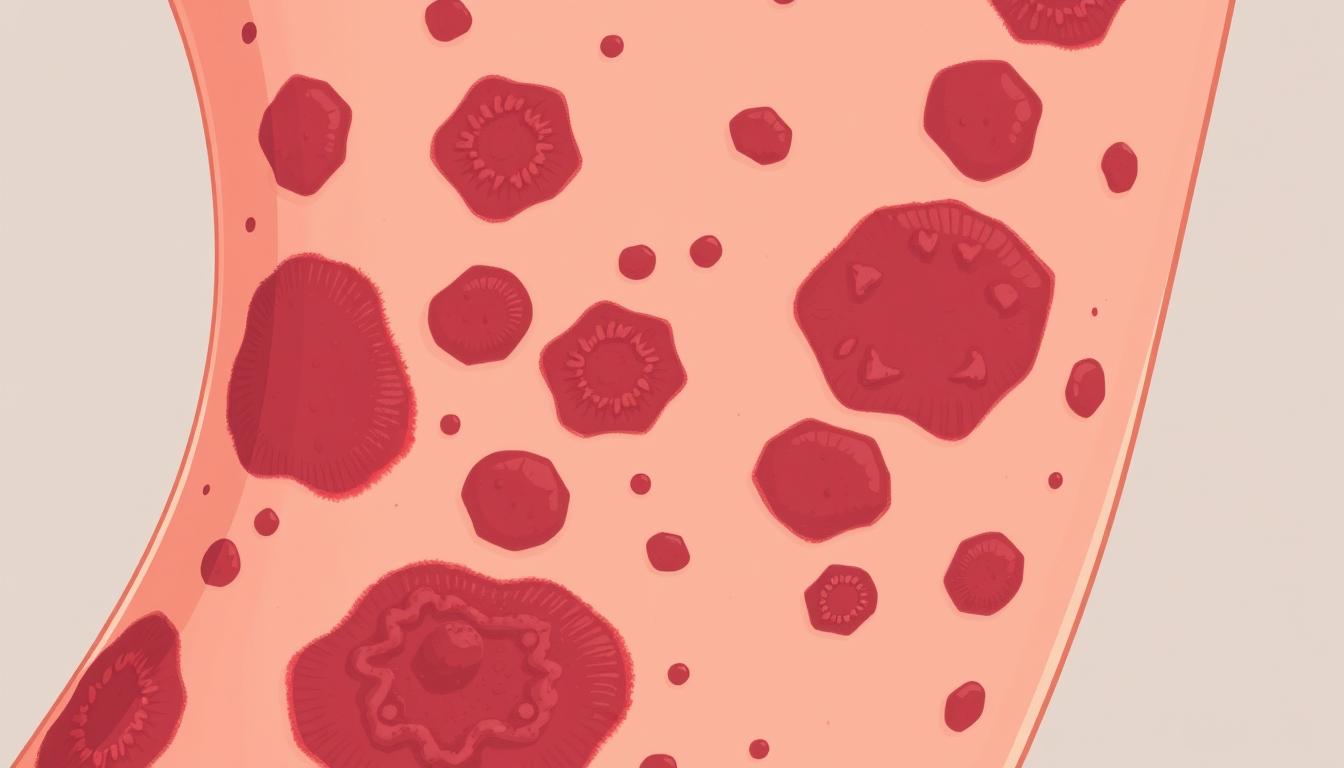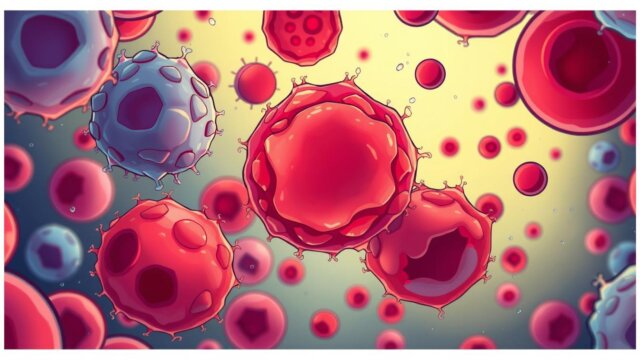FTC disclaimer: This post may contains affiliate links and we will be compensated if you click on a link and make a purchase.
Kaposi sarcoma is rare cancer that affects only 0.03% of people in the U.S. It’s a serious disease that grows in blood and lymph vessel linings. This leads to skin, organ, and mucous membrane lesions.
Knowing about its causes, risks, and treatments is key. It helps those affected and their families.
Key Takeaways
- Kaposi sarcoma is a type of cancer that develops in the lining of blood and lymph vessels.
- It is almost always caused by infection with the human herpesvirus 8 (HHV-8), also known as Kaposi sarcoma-associated herpesvirus (KSHV).
- Kaposi sarcoma is more common in people with weakened immune systems, such as those with HIV/AIDS or who have received organ transplants.
- There are several different types of Kaposi sarcoma, including epidemic, classic, endemic, and iatrogenic.
- Kaposi sarcoma can be treated, but it may recur, so ongoing monitoring and care is important.
What is Kaposi Sarcoma?
Overview of Kaposi Sarcoma
Kaposi sarcoma is a cancer that starts in blood and lymph vessel cells. It causes lesions to appear on the skin, organs, and mucous membranes. These lesions can be purple, red, or brown and may be flat or raised.
Kaposi sarcoma is rare. Its numbers have gone down because of better HIV/AIDS treatments.
There are four main types of Kaposi sarcoma: AIDS-related, transplant-associated, classic, and endemic. AIDS-related Kaposi sarcoma is common in HIV-infected people. Transplant-associated Kaposi sarcoma happens in those who have had an organ transplant and take immune-suppressing drugs.
Classic Kaposi sarcoma is seen more in older men of certain ancestries. Endemic Kaposi sarcoma mainly affects young people in Africa.
Kaposi sarcoma can grow fast and be deadly if lesions appear in the lungs, liver, or digestive tract. In places where HAART is hard to get, AIDS patients with Kaposi sarcoma can get very sick fast.

“Kaposi sarcoma is a rare cancer, and its prevalence has declined in recent years due to improved treatments for HIV/AIDS.”
Causes of Kaposi Sarcoma
Kaposi sarcoma is almost always caused by an infection with the human herpesvirus 8 (HHV-8), also known as Kaposi sarcoma-associated herpesvirus (KSHV). This virus is in the same family as the Epstein-Barr virus. While the virus can be transmitted, most people who are infected with HHV-8 never develop Kaposi sarcoma. The cancer typically develops in people with weakened immune systems, such as those with HIV/AIDS or who have received organ transplants and take immunosuppressant drugs.
Interestingly, less than 1 percent of the general U.S. population is a carrier of human herpesvirus 8, the virus that causes Kaposi sarcoma. However, during the AIDS epidemic in the U.S., the incidence of Kaposi sarcoma reached more than 20 times the pre-epidemic numbers, with 47 cases per year for every 1 million people. Currently, Kaposi sarcoma yields about 6 cases per 1 million people per year in the U.S. Additionally, around 20 percent of patients with Kaposi sarcoma today have tumors beyond their skin or lymph nodes.
Patients receiving organ transplants are also at a higher risk of developing Kaposi sarcoma, especially in regions where KSHV is more common, such as Italy or Saudi Arabia. Furthermore, KS predominantly affects men or people assigned male at birth (AMAB), with eight times more cases reported in this group compared to women or people assigned female at birth (AFAB). Among individuals with HIV, men or people AMAB who have sex with other men or people AMAB are more likely to contract the virus and develop KS.
The prevalence of classic (Mediterranean) KS is higher in older individuals of Mediterranean, Middle Eastern, or Eastern European descent, particularly in men or people AMAB. Children and young individuals in Africa are at a higher risk of endemic (African) KS due to increased exposure to Kaposi sarcoma-associated herpesvirus (KSHV). Immunocompromised individuals, such as those who have undergone organ transplants or are on immunosuppressant medication, face a greater risk of developing immunosuppressive (iatrogenic or transplant-related) KS.
Antiretroviral therapy (ART) for HIV has led to an 80%-90% decrease in KS cases since the early 1980s. The rate of survival after a KS diagnosis varies based on the spread of the cancer. Approximately 75% of individuals with KS survive at least 5 years post-diagnosis, with those whose cancer hasn’t spread having an 81% survival rate. Clinical trials are exploring targeted therapies like monoclonal antibody therapy and tyrosine kinase inhibitors to treat KS without harming healthy cells.
In summary, Kaposi sarcoma is primarily caused by an infection with the human herpesvirus 8 (HHV-8), which is more prevalent in certain regions and populations. Understanding the causes and risk factors associated with this cancer is crucial for early detection, effective treatment, and improved patient outcomes.
Extracted from link 1Extracted from link 2
Risk Factors for Kaposi Sarcoma
Who is at Risk for Developing Kaposi Sarcoma?
Kaposi sarcoma is a rare cancer that hits people with weak immune systems hard. We don’t know all the causes, but some risk factors are clear. Men are more likely to get KS than women. People from Mediterranean, Italian, or Eastern European Jewish backgrounds also face a higher risk.
Living in certain parts of Africa ups the risk for some KS types. Infection with human herpesvirus-8 (HHV-8) is key for KS to develop, but most HHV-8 carriers don’t get the disease. Those with HIV/AIDS or on immunosuppressants after a transplant are at greater risk.
Men who have sex with men are also at higher risk, likely because they’re more likely to have both HHV-8 and HIV. Age matters too, with classic KS mostly hitting people over 50.
Risk Factor | Significance |
|---|---|
Gender | Men have a higher risk for Kaposi sarcoma than women. |
Ethnicity | People of Mediterranean, Italian, or Eastern European Jewish descent are at a higher risk for classic Kaposi sarcoma. Those living in certain parts of Africa have a higher risk for some types of KS. |
Immune System | Individuals with weakened immune systems, such as those with HIV/AIDS or organ transplant recipients, face a higher risk of Kaposi sarcoma. |
Sexual Orientation | Men who have sex with men are at an elevated risk for Kaposi sarcoma, likely due to a higher likelihood of being infected with both HHV-8 and HIV. |
Age | The classic form of Kaposi sarcoma primarily affects older individuals, typically over the age of 50. |
Types of Kaposi Sarcoma
Kaposi sarcoma is a cancer that comes in different forms. Each form has its own traits and risk factors. The main types are AIDS-Related Kaposi Sarcoma, Classic Kaposi Sarcoma, Endemic Kaposi Sarcoma, and Transplant-Related Kaposi Sarcoma.
AIDS-Related Kaposi Sarcoma is common in the US. It often affects people with HIV. This type is linked to the human immunodeficiency virus.
Classic Kaposi Sarcoma mainly hits older men. They must be over 60 and from Mediterranean, Eastern European, or Middle Eastern backgrounds. Men are more likely to get this type than women.
- Endemic (or African) Kaposi Sarcoma is more common in people under 40.
- Transplant-related Kaposi Sarcoma happens in organ transplant patients on immunosuppressants.
Using antiretroviral therapy has helped lower Kaposi sarcoma cases in HIV patients.
Type of Kaposi Sarcoma | Key Characteristics |
|---|---|
AIDS-Related Kaposi Sarcoma | The most common type in the US is linked to HIV infection |
Classic Kaposi Sarcoma | Affects older men of Mediterranean, Eastern European, or Middle Eastern descent; men are more likely to develop this form. |
Endemic Kaposi Sarcoma | More likely to occur in individuals under 40 years old |
Transplant-Related Kaposi Sarcoma | Develops in organ transplant recipients taking immunosuppressant medications |
Knowing about the different Kaposi sarcoma types is key for correct diagnosis and treatment. Each type has its own signs and risks. Doctors must consider these when planning treatment.
Symptoms of Kaposi Sarcoma
Kaposi sarcoma is a cancer that shows up in different ways. It mainly affects the skin, mucous membranes, and internal organs. The first sign is usually lesions or abnormal growths. These can be purple, red, or brown and may be flat or raised.
These growths often start on the legs and feet, especially the ankles and soles. Kaposi sarcoma can also affect the mucous membranes like the mouth, anus, or the inside of the body. This can cause pain, swelling, or breathing problems.
Lesions in the lungs can lead to coughing or coughing up blood. In the stomach or intestines, they can cause pain, bleeding, and anemia.
The symptoms can change based on the disease’s type and stage. Some forms grow fast, while others take years. Getting a proper diagnosis and treatment is key to managing symptoms and improving life quality.
Not everyone with the virus will get Kaposi sarcoma. But people with weak immune systems, like those with HIV or taking certain medications, are at higher risk. It’s vital to get medical help quickly and follow treatment to manage symptoms and improve chances of recovery.
Diagnosis of Kaposi Sarcoma
Early diagnosis is key to managing Kaposi sarcoma (KS) well. It helps improve outcomes and lowers the risk of the disease spreading. Healthcare providers do a physical examination and order various tests to diagnose KS.
How is Kaposi Sarcoma Diagnosed?
A skin biopsy is the main way to confirm KS. A small tissue sample is taken from a suspected lesion and checked under a microscope. Chest X-rays and CT scans check for KS in the lungs. Bronchoscopies examine the airways for signs of the disease.
For the gastrointestinal tract, healthcare providers might use endoscopic procedures like upper endoscopy (EGD) and colonoscopy to find lesions. They might also use capsule endoscopy or double-balloon enteroscopy to check the small intestine.
Healthcare providers also look at the patient’s medical history and risk factors when diagnosing KS. People with weakened immune systems, like those with HIV/AIDS, are more likely to get the disease.
Diagnostic Test | Purpose |
|---|---|
Skin Biopsy | Confirm KS diagnosis by examining a tissue sample |
Chest X-Ray and CT Scan | Check for KS lesions in the lungs |
Bronchoscopy | Examine the airways for signs of KS |
Upper Endoscopy (EGD) and Colonoscopy | Detect KS lesions in the gastrointestinal tract |
Capsule Endoscopy and Double Balloon Enteroscopy | Inspect the small intestine for abnormalities |
By doing a thorough evaluation, healthcare providers can accurately diagnose Kaposi sarcoma. They can then create a good treatment plan. Early detection is key to better outcomes and stopping the disease from spreading.
Treatment for Kaposi Sarcoma
When treating Kaposi sarcoma (KS), the main goal is to strengthen the patient’s immune system. This is especially important for those with HIV/AIDS. For them, antiretroviral therapy is key. It fights the virus and boosts the immune system.
Transplant patients might need to adjust their immunosuppressant drugs. This can help lessen KS lesions and improve health.
Local therapies like injections or radiation can treat small lesions. These methods are effective for localized KS without needing widespread treatment.
If other treatments fail or the disease spreads, chemotherapy might be needed. Chemotherapy can control KS lesions, especially in severe cases.
Treatment Approach | Description |
|---|---|
Immune System Strengthening | The main goal is to boost the patient’s immune system. This often involves antiretroviral therapy for HIV/AIDS patients. |
Immunosuppressant Drug Adjustment | Transplant recipients might adjust or reduce immunosuppressant drugs. This can lessen KS lesions. |
Local Therapies | Treatments like injections or radiation can target small lesions. They are effective without systemic treatment. |
Chemotherapy | Chemotherapy is used when other treatments fail or the disease spreads. It controls KS lesions. |
Kaposi sarcoma treatment varies based on the patient’s needs. It considers the type of KS, lesion extent, and overall health. A mix of treatments can manage this complex condition.
Kaposi Sarcoma
Kaposi sarcoma (KS) is a rare cancer caused by the human herpesvirus 8 (HHV-8). This virus leads to abnormal cell growth. It causes lesions or tumors on the skin, mucous membranes, and internal organs.
People with weakened immune systems are more likely to get KS. This includes those with HIV/AIDS or who have had organ transplants and take drugs to suppress their immune system.
There are four main types of Kaposi sarcoma. Classic KS affects older men from Eastern Europe, the Middle East, and the Mediterranean. It grows slowly.
Epidemic (AIDS-related) KS is common in people with HIV and AIDS. Endemic (African) KS affects people of all ages in Africa. Immunosuppression-associated KS happens in those who have had organ transplants and are on immune-suppressing drugs.
The lesions of Kaposi sarcoma look like bluish-red or purple bumps. They can cause bleeding and other symptoms. While there’s no cure for the virus, treatments like antiviral therapy and chemotherapy can help manage symptoms.
Statistic | Value |
|---|---|
New cases of Kaposi Sarcoma in 2018 | 42,000 |
Deaths due to Kaposi Sarcoma in 2018 | 20,000 |
Percentage of people with AIDS affected by Kaposi Sarcoma | Over 35% |
Incidence of classic KS in the UK before the AIDS epidemic | Around 0.01 per 100,000 person-years |
Incidence of classic KS in the USA before the AIDS epidemic | 0.2 per 100,000 person-years |
Incidence of endemic KS in Africa before the AIDS epidemic | Over 6 per 1,000 person-years |
Incidence of iatrogenic KS in solid-organ transplant recipients | Approximately 200 times higher than in the general population |
KSHV, the virus linked to Kaposi sarcoma, can spread through kissing. All types of Kaposi sarcoma are caused by KSHV, showing different symptoms and risks. The virus’s spread varies by location, affecting the disease’s prevalence.
In conclusion, Kaposi sarcoma is a serious but treatable cancer caused by HHV-8. Knowing the types, risks, and treatments can help those with weakened immune systems manage the disease and improve their life quality.
Living with Kaposi Sarcoma
Coping and Support for Kaposi Sarcoma Patients
Living with Kaposi sarcoma is tough and can feel very draining. It’s key to work closely with your healthcare team. This team might include doctors like dermatologists and oncologists to find the best treatment.
Some people with KS need treatments like chemotherapy or radiation. These treatments can have side effects, some of which last forever.
Getting emotional support is also very important. Look into or join a support group. This way, you can meet others who know what you’re going through. Kaposi sarcoma is a common cancer in people with HIV, along with non-Hodgkin lymphoma.
It’s also important to keep your health insurance after treatment. Tests and doctor visits can be expensive. Keep copies of your medical records for new doctors.
While no supplements can clearly lower cancer risk, healthy habits can help. Don’t smoke, eat well, and stay active. Keeping your immune system strong is key for people with KS.
With the right care and support, many patients can manage their disease well. KS can happen even when HIV treatment is working. Patients with KS that come back have options based on where the cancer is and their health.
“With the right treatment and support, many Kaposi sarcoma patients are able to manage their disease and maintain a good quality of life.”
Conclusion
Kaposi Sarcoma is a rare cancer caused by the human herpesvirus 8 (HHV-8). It leads to skin, mucous membrane, and organ growths. It’s more common in people with weak immune systems.
There’s no cure for the virus, but treatments can help manage symptoms. These include boosting the immune system and using chemotherapy. Early treatment helps many patients live well with the disease.
Studies have looked into Kaposi Sarcoma’s causes and how it progresses. Research is ongoing to find better treatments. This gives hope for better outcomes for those with Kaposi Sarcoma.
FAQ
What is Kaposi sarcoma?
Kaposi sarcoma is a cancer that starts in blood and lymph vessel linings. It causes abnormal growths on the skin, organs, and mucous membranes.
What causes Kaposi sarcoma?
Kaposi sarcoma is caused by an infection with human herpesvirus 8 (HHV-8), also known as Kaposi sarcoma-associated herpesvirus (KSHV).
Who is at risk for developing Kaposi sarcoma?
People at risk include those with HIV/AIDS, organ transplant recipients, and those from Mediterranean, Middle Eastern, or Eastern European backgrounds.
What are the different types of Kaposi sarcoma?
There are four main types: AIDS-related, classic, endemic, and transplant-related Kaposi sarcoma.
What are the symptoms of Kaposi sarcoma?
Symptoms include lesions on the skin, mucous membranes, and organs. These can be purple, red, or brown and flat or raised.
How is Kaposi sarcoma diagnosed?
Doctors perform physical exams and may order tests like skin biopsies and X-rays. They also do bronchoscopies, endoscopies, and colonoscopies.
How is Kaposi sarcoma treated?
Treatment aims to boost the immune system. This includes antiretroviral therapy for HIV/AIDS patients and adjusting immunosuppressant drugs for transplant recipients. Local therapies and chemotherapy are also used.








